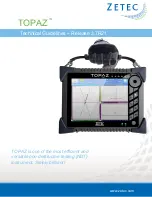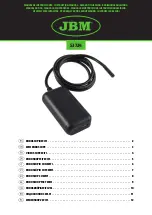
Using the Patch Clamp
EPC9 Manual
77
If you are applying voltage pulses to the patch membrane, you probably will want to
subtract control traces from the traces containing the channels of interest in order to
remove the capacitive transients. Nevertheless, it is important to try to cancel the
capacitive transients as well as you can in order to avoid saturating any amplifiers,
the recording medium or the AD converter. It is a good idea to set the
C-fast
and
τ
-
fast
controls while you observe the signal without any filtering beyond the internal
10 kHz filter. Then, during the recording, watch to see if the
Clipping
light blinks.
When it does, it means that internal amplifiers in the EPC9 are about to saturate,
and/or that the
Current Monitor
output voltage is going above 13 V peak, on the
peaks of the transients, and you should readjust the transient cancellation controls.
Otherwise, it is likely that the recording will be non-linear and subtraction will not
work correctly.
The fast transient cancellation is not sufficient to cancel all of the capacitive
transients in a patch recording. This is partly because the pipette capacitance is
distributed along the length of the pipette; therefore, each element of capacitance has
a different amount of resistance in series with it, so that a single value of
τ
-fast
will
not provide perfect cancellation. The time course of the transients also reflects
dielectric relaxation in the plastic of the pipette holder and in the pipette glass. These
relaxations are not simple exponentials, but occur on time scales of about 1 ms. If
you use pipette glass with low dielectric loss (e.g., aluminosilicate glass) or if you are
careful to coat the pipette with a thick coating and near to the tip, the relaxations will
be smaller. You can cancel part of these slow relaxations by using the
C-slow
controls,
with the
C-slow Range
set to 3 pF.
Note:
For cell-attached or inside-out patch configuration, positive pipette voltages
correspond to a hyperpolarization of the patch membrane, and inward membrane
currents appear as positive signals at the Current Monitor outputs. The E9Screen and
Pulse programs compensate for this by inverting digital stimulus and sampled values
in these recording configurations such that the stimulation protocols, holding
voltages, and displays of current records in the oscilloscope all follow the standard
electrophysiological convention. In this convention, outward currents are positive
and positive voltages are depolarized. However, the analog current and voltage
monitor outputs are not inverted in these recording modes.
Whole-Cell Recording
Breaking the Patch
After a gigaseal is formed, the patch membrane can be broken by additional suction
or, in some cells, by high voltage pulses (600-800 mV, see
Zap
function). Electrical
access to the cell's interior is indicated by a sudden increase in the capacitive
transients from the test pulse and, depending on the cell's input resistance, a shift in
















































